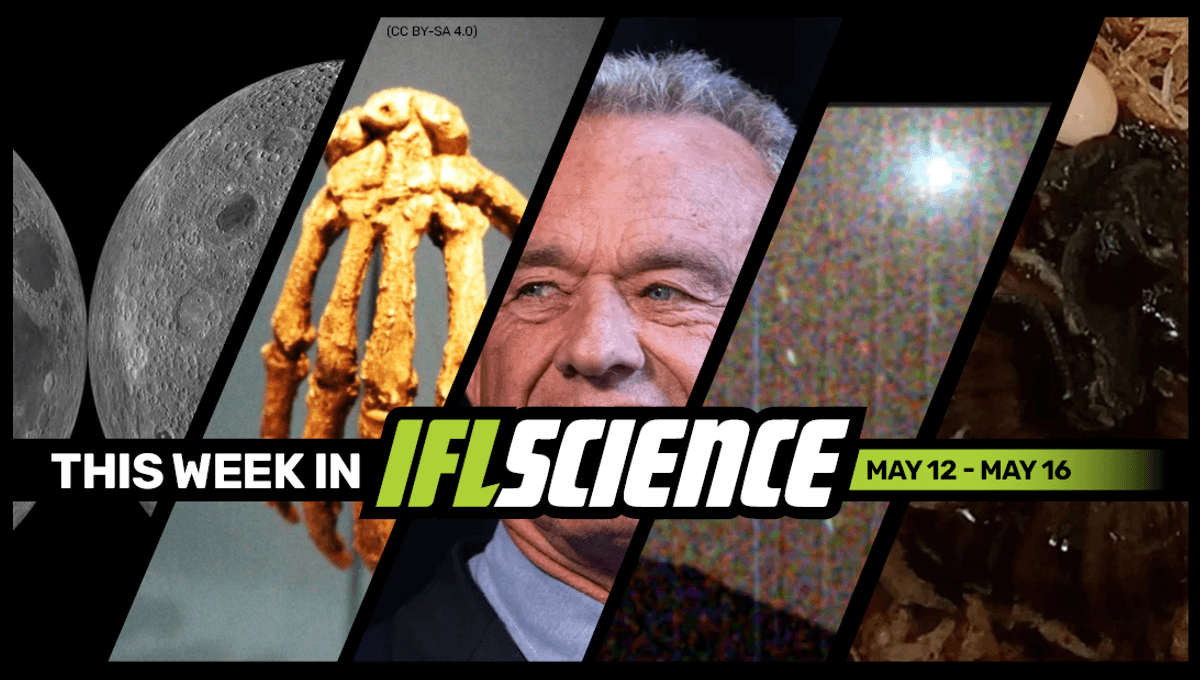
This week, Homo naledi – the extinct human species of Netflix fame – had hands that were partially adapted to climbing, new research has revealed. Robert F. Kennedy Jr, the US health secretary, says people shouldn’t take medical advice from him, and for the first time ever, visible aurorae have been seen from the surface of Mars – and it’s green. Finally, on the 40th anniversary, we spoke to some of the scientists involved in one of the greatest geophysical findings of the 20th century – the ozone layer hole discovery that saved the planet.
Create an IFLScience account to get all the biggest science news delivered straight to your inbox every Wednesday and Saturday.
There Is Something Odd Going On Inside The Moon
Since the first observation of the far side of the Moon in the 1960s, it has been clear that there are major differences between the side of the Moon that we always see and the one that is always pointing away from us. The newest analysis has revealed that this difference is not skin-deep, but profound. The Moon’s interior on the nearside is very different from that on the far side and we might know why. Read the full story here
Homo Naledi Had Hands That Rock Climbers Would Be Jealous Of
Homo naledi – the extinct human species of Netflix fame – had hands that were partially adapted to climbing and partly designed for crafting, new research has revealed. This finding helps to fill in a gap in our understanding of human hand evolution, suggesting that the manual hardware required for tool-making and other fiddly tasks started to develop before we lost our ape-like grip. Read the full story here
Health Secretary Robert F. Kennedy Jr. says People Shouldn’t Take Medical Advice From Him
In his first Congressional hearing since his confirmation, US Health and Human Services Secretary Robert F. Kennedy Jr. has avoided sharing his beliefs and defended deep cuts to health institutes. Specifically, Democrat members have been pushing for answers on the impact of the Trump budget on health as well as what Kennedy really believes in terms of medicine. Read the full story here
First Ever Visible Green Aurorae Seen On Mars
Astronomers have reported an incredible new observation: Mars not only has the bizarre proton aurorae that have been detected from orbit, it also has green aurorae like those here on Earth, generated by charged solar wind particles hitting the very scarce oxygen atoms in the thin Martian atmosphere. This is not only the first detection of visible light aurorae on Mars, it is also the first detection of any type of aurora from the ground on a planetary body other than Earth. Read the full story here
Long-Lived, Carnivorous, And Freaky: Watch These Snails Lay Eggs Through Their Necks
It is undoubtedly true in conservation circles that things that are cute and fluffy get the most attention. After all, who can resist something as adorable as Madame Berthe’s mouse lemur? The slimier inhabitants of Earth typically have to do something a little more interesting than just looking cute to get headlines. Enter Powelliphanta augusta, a snail species that lays eggs through its neck. Read the full story here
TWIS is published weekly on our Linkedin page, join us there for even more content.
Feature of the week:
“This Story Is A Good One”: 40 Years Ago, Scientists Discovered A Hole In The Ozone Layer And Saved The Planet
Forty years ago today, a trio of UK scientists reported that something strange and very unexpected was occurring over Antarctica. They didn’t know it at the time, but they had “accidentally” (their words, not ours) made one of the greatest geophysical discoveries of the 20th century and started one of the most important scientific stories of recent memory. Read the full story here
More content:
CURIOUS Live, IFLScience’s virtual event, is back for 2025! This time, we’ll be discussing all things horror and neuroscience with Dr Austin Lim. Sign up for an All Access Membership today and receive free access to the event as one of the many perks of an All Access Membership.
Have you seen our e-magazine, CURIOUS? Issue 34, May 2025, is available now. This month we asked, “Why Do We Love Nostalgia?” – check it out for exclusive interviews, book excerpts, long reads, and more.
PLUS, the We Have Questions podcast – an audio version of our coveted CURIOUS e-magazine column – continues. In episode 8, we ask, “What Happens To Eyes During The Mummification Process?”
The Big Questions podcast returns next month for season 5. Catch up with all past episodes here.
Source Link: There Is Something Odd Going On Inside The Moon, Watch These Snails Lay Eggs Through Their Necks, And Much More This Week